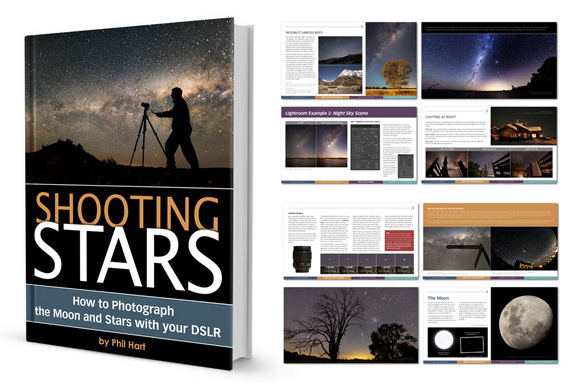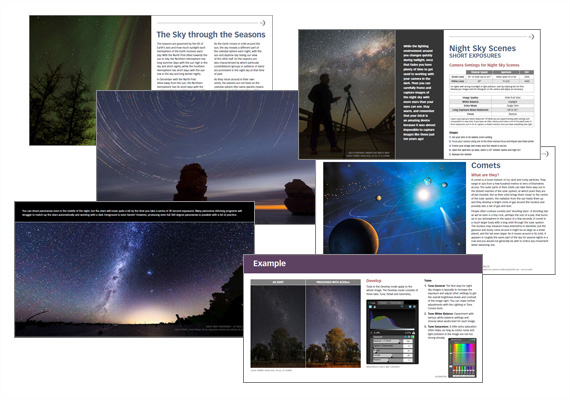Capturing star trails and other night sky scenes is truly one of the most technically difficult forms of photography. This popular in-depth eBook written by David Malin Astrophotography Award winner Phil Hart, will show you how to shoot your own stunning images of the moon and the stars with just your digital SLR and a tripod. Version 4 was just released with 30 more pages in a new section on how to do star tracking. We were able to arrange an exclusive 50% discount today if you want to check it out. Deal ending soon: Shooting Stars – How to Photograph the Moon & Stars at 50% Off
Designed to help you master these styles in particular:
- Twilight landscapes
- Night sky scenes (shorter exposures)
- Star trails (long exposures)
- The Moon
- Night sky timelapse videos
In order to accomplish this, the guide is organized into four parts:
Part 1, The Sky at Night, introduces some basic astronomy concepts, to help you understand what you can expect to see at night from different places on Earth and at different times of the year.
Part 2, Night Sky Photography, is the heart of the book. It begins by discussing your camera and lenses and how to use them to turn the faint light of the night sky into stunning images. Most importantly, it describes three techniques for how to get accurate focus at night when your autofocus fails you. At least one of these techniques is guaranteed to work with whatever camera and lens you are using. This section also describes additional equipment and accessories that will enable you to do more with your camera at night and help make the experience more enjoyable.
Part 3 covers Image Processing, concentrating on the particular techniques and steps you will need to get the most out of your night sky images. Examples and screen captures are provided for Photoshop, Lightroom, ACDSee and Aperture but the instructions can easily be applied using any other image processing application.
Part 4, Wonders of the Night Sky, will inspire you to get outside with your camera more often. This final part covers interesting events, features and phenomena that you can see at night and how to apply night sky photography techniques to capture them. This part also features many of Phil’s stunning images and the stories behind them.
Part 5, the Field Guide provides a quick summary of the exposure settings you need for each style of night sky photography. It also describes where to find camera settings particular to this type of photography on popular DSLRs from Canon, Nikon, Olympus, Pentax and Sony.
Tracking the Stars, Part 6 of Shooting Stars, is entirely new in 2021 (4th edition).
It will show you how to polar align and use portable tracking mounts such as the Sky-Watcher Star Adventurer with DSLRs and telephoto lenses. Image processing techniques to calibrate and stack your deep sky images are provided for three popular software packages: Photoshop, Deep Sky Stacker and Astro Pixel Processor.
This new section marks a step up from “Night Sky Photography” using camera and tripod only to long-exposure “Astrophotography” with standard and telephoto lenses on tracking mounts.
Two of the hardest steps when making this transition are learning how to polar align these equatorial mounts and how to ‘calibrate and stack’ multiple sub-exposures in dedicated astro-imaging software. Tracking the Stars has 30 pages of new content covering these two foundational skills in detail, to get your journey in astrophotography started on the right track.
Phil Hart has been practicing night sky photography for nearly 20 years and currently teaches workshops in Melbourne, Australia.
How to Get Shooting Stars for a Discount Today:
We were able to arrange an exclusive 50% discount today for PictureCorrect readers which ends soon (normally $19.95, today just $9.95). It also carries a 90 day happiness guarantee, if you are not satisfied with any part of the book just let us know and we will give you a full refund so there is no risk in trying it.
Deal ending soon: Shooting Stars: How to Photograph the Moon and Stars at 50% Off
Like This Article?
Don't Miss The Next One!
Join over 100,000 photographers of all experience levels who receive our free photography tips and articles to stay current:








Leave a Reply